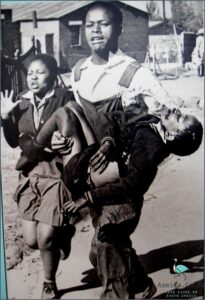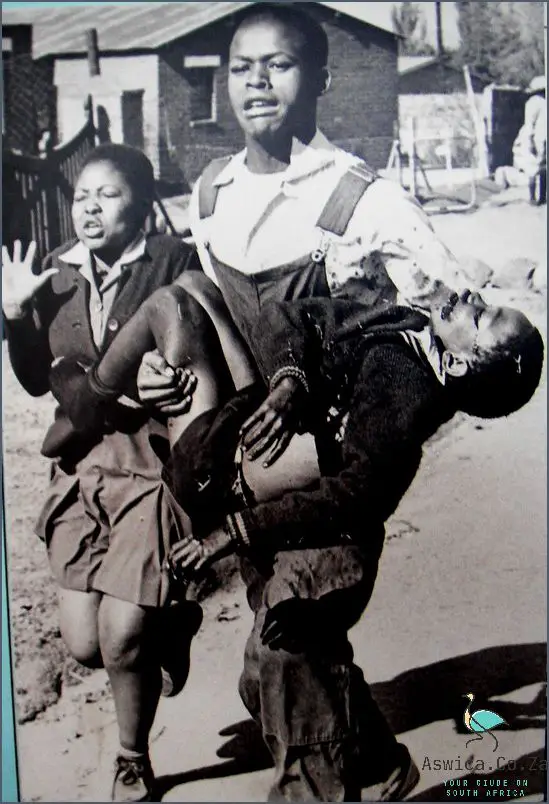
16 June 1976 is a day of immense historical significance in South Africa’s history. On this day, thousands of black students marched in protest of the apartheid government’s decision to enforce Afrikaans as a medium of instruction in all schools. This protest, which was known as the Soweto Uprising, quickly spread across the country and sparked a mass anti-apartheid movement. The protesters were met with force from the government, leading to the death of more than 700 people, with many more injured. The Soweto Uprising was a significant event in the long struggle against apartheid, and a major turning point in the fight for racial equality in South Africa. It is commemorated each year on 16 June to remember the sacrifices made by the protesters and to pay tribute to their courage and determination.
Contents
- 1 16 June 1976
- 2 The Day of the Youth Uprising – Overview of the events that took place in Soweto and other townships
- 3 Impact of the Uprising – Political and social changes that followed the day of the youth revolt
- 4 Legacy of the Uprising – Overview of how 16 June 1976 is remembered and honored in South Africa today
- 5 Conclusion
16 June 1976
16 June 1976 is remembered as a day of tragedy in South Africa, when police opened fire on a peaceful protest in Soweto. This incident sparked the Soweto Uprising, a two-week period of civil unrest across the country. The event has become a symbol of the struggle against Apartheid and the repression of the South African people by the government. It is remembered as a day when the people of South Africa began to rise up against the oppressive measures of the Apartheid regime and fight for their right to freedom. The violence that erupted that day led to the deaths of hundreds of people and inspired others, both in South Africa and around the world, to join the struggle for human rights and self-determination. The legacy of 16 June 1976 lives on in the hearts of those who still fight for freedom and justice in South Africa.
The Day of the Youth Uprising – Overview of the events that took place in Soweto and other townships
The Day of the Youth Uprising on June 16, 1976, is a powerful reminder of the bravery and resilience of South Africa’s youth in their fight against apartheid. This momentous day in the history of South Africa saw the uprising of the youth in townships across the country, most notably in Soweto, to protest against the government’s policy of implementing Afrikaans as the language of instruction in schools.
The events that took place in Soweto and other townships on that day were a result of a series of oppressive policies imposed by the apartheid government. The African National Congress (ANC) had been banned in 1960, and the government had implemented a number of policies that aimed to ghettoize and further marginalize black South Africans. This included the introduction of the Bantu Education Act in 1953, which aimed to limit the educational opportunities for black students and kept them underfunded.
On June 16, 1976, a peaceful march of thousands of students from Soweto and other townships began in protest against the government’s policies and the introduction of Afrikaans as the language of instruction in schools. The students were met with a violent response from the police, who opened fire on the unarmed protesters.
News of the violent crackdown spread throughout the townships, and soon the protests had grown to include thousands of people. Other townships across the country, including Alexandra, Tembisa, and Mamelodi, also joined in the protests. The police response was swift and brutal, and in the days that followed, hundreds of people were killed and injured.
The Day of the Youth Uprising is remembered as a pivotal moment in the struggle against apartheid, and one that demonstrated the courage and resilience of the youth of South Africa. It has become a symbol of the struggle and a reminder of the power of collective action and the power of young people to effect change.
The legacy of the Day of the Youth Uprising lives on, and it is a reminder of the importance of standing up for what is right and of the power of collective action in the pursuit of justice and equality. The courage and resilience of the young people of South Africa on that day is still remembered and celebrated to this day.
The 16th of June 1976 saw the beginning of a youth uprising in South Africa, an event that would go down in history as one of the most significant moments of the anti-apartheid movement. This day of revolt, also known as the Soweto Uprising, was sparked by a group of students protesting against the oppressive policies of the white minority government and the forced implementation of Afrikaans as a medium of instruction in schools. The uprising quickly spread across the country and resulted in a wave of civil unrest that would have far-reaching political and social ramifications.

The events of the 16th of June provided the impetus for a wave of protests and strikes that would eventually lead to the end of apartheid. In the immediate aftermath of the uprising, the government responded with a heavy-handed crackdown on protesters, resulting in the death of hundreds of people and the imprisonment of thousands. This brutal repression, however, only served to further galvanise the opposition and the subsequent weeks and months saw a mass-mobilisation of South Africans from all walks of life, united in their demand for an end to the oppressive regime.
The uprising also had a profound impact on South African society. It provided a platform for the expression of long-buried grievances and sparked a dialogue on issues such as racial inequality and social injustice. This dialogue, in turn, gave rise to a series of social movements that sought to challenge the status quo and highlight the inequality and oppression faced by the majority of South Africans.
Politically, the uprising marked a turning point in the struggle against apartheid. It provided a clear indication to the international community of the determination of the people of South Africa to end the oppressive regime and, as a result, galvanised support for the anti-apartheid movement from the international community. This, in turn, provided the impetus for a series of sanctions imposed on the South African government, which eventually led to the end of apartheid.
In conclusion, the Soweto Uprising of 16 June 1976 was a pivotal event in South Africa’s history. It provided the impetus for a wave of civil unrest that resulted in the overthrow of the oppressive regime of apartheid and brought about profound political and social changes in the country. The legacy of the uprising continues to be felt to this day and serves as a reminder of the power of the people to effect change.
Legacy of the Uprising – Overview of how 16 June 1976 is remembered and honored in South Africa today
The 16th of June 1976 marks a momentous day in South African history. The legacy of the uprising that occurred on that day still lives on in South Africa today.
The day is remembered as a day of resistance and defiance against the oppressive apartheid government of the time. The uprising was a watershed moment in South African history and it is remembered as a symbol of the courage and strength of the oppressed people in the face of an unjust system.
The uprising was sparked by a demonstration of over 10,000 students in the Soweto township of Johannesburg. The protest was against the implementation of Afrikaans as the language of instruction in schools, which was seen as an attempt to further suppress black South Africans. The government responded with force and the demonstration quickly spiraled into an uprising of protests and strikes throughout the country. This is known as the Soweto Uprising.
The legacy of the Soweto Uprising lives on in South Africa today. It is remembered as a symbol of the bravery and courage of the people in the face of oppression. Every year on June 16, South Africans from all walks of life come together to commemorate the brave individuals who stood up against the oppressive apartheid government.
The day is remembered with a mix of solemnity and celebration. It is a day to remember the brave individuals who fought for freedom and justice, and to recognize the progress made since the uprising. There are several events and activities held throughout the country to commemorate the day. In addition, there are memorials and monuments erected in remembrance of the brave individuals who sacrificed their lives for a better future.
The legacy of the Soweto Uprising is a reminder of a painful past, but it is also a reminder of the power of the people to stand up and fight for what is right. It is a reminder of the courage and strength of the people and their commitment to justice and freedom. The 16th of June will forever be remembered as a day of hope and courage for South Africans.
Conclusion
The Soweto Uprising was a turning point in the struggle against apartheid in South Africa. On 16 June 1976, thousands of black students took to the streets of Soweto to protest the inferior quality of their education. The protest quickly turned into a full-blown rebellion against the apartheid regime. The uprising was met with brutal force by the police, but the students continued to fight. The Soweto Uprising showed the world that the people of South Africa were willing to fight for their freedom, and it was a major factor in the eventual downfall of the apartheid regime.



